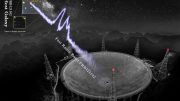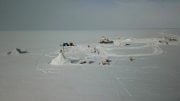Scientists at Lawrence Berkeley National Laboratory wrote on this penny with an ion beam to show off how cool nanoscience research can be. Credit: Video courtesy of Lawrence Berkeley National Laboratory
What is Nanoscience?
Nanoscience is the study of matter at the nanoscale—dimensions between approximately 1 and 100 nanometers or 1,000 times smaller than the width of a human hair. At these incredibly small scales, materials have unique phenomena that enable new applications. In 1959, the famed physicist Richard Feynman said in a prophetic lecture that there was “plenty of room at the bottom.” Feynman meant that exploring and manipulating materials almost atom by atom would create huge opportunities for new science and important new technologies. Today that “room at the bottom” is called nanoscience. It is an important part of research in physics, chemistry, materials science, and biology.
You can literally see the impact of this research on television. Some video screens today use a U.S.-developed nanotechnology called quantum dots. The technology creates televisions with very high-resolution and precise, vivid colors.
Nanoscience Facts
- The word nano is from the Greek word ‘nanos,’ meaning dwarf. It is a prefix used to describe one billionth of something. A nanometer is one billionth of a meter.
- The Department of Energy Office of Science has a key role in the National Nanotechnology Initiative (NNI), a U.S. government research and development effort that envisions a future where nanotechnology leads to a revolution in technology and industry.
DOE Office of Science: Contributions to Nanoscience
Nanoscience is fundamental to progress in almost every area of technology. To meet this need, DOE Office of Science’s Office of Basic Energy Sciences (BES) established five Nanoscale Science Research Centers. These centers conduct interdisciplinary collaborative research at the nanoscale. They provide access to leading-edge synthesis, characterization, computational tools, and scientific expertise. Working with leading scientists, the centers create materials and structures with atomic-scale precision to characterize, understand, and predict their properties.
The centers are located near existing X-ray and neutron probes as well as advanced computing facilities so that researchers can use these tools in tandem. BES also supports a broad range of pioneering research in nanoscale science and engineering. This research supports the Department of Energy’s mission to advance the energy, economic, and national security of the United States. Building on this foundation of discovery research, scientists supported by both the government and industry are pursuing applied nanotechnology research.









Be the first to comment on "Science Made Simple: What is Nanoscience?"